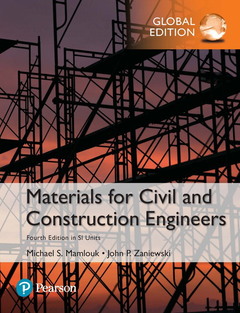Description
Materials for Civil and Construction Engineers in SI Units (4th Ed.)
Authors: Mamlouk Michael, Zaniewski John
Language: English
Subject for Materials for Civil and Construction Engineers in SI Units:
92.37 €
In Print (Delivery period: 14 days).
Add to cart664 p. · 18x23 cm · Paperback
Description
/li>Contents
/li>Biography
/li>Comment
/li>
Civil and Construction Engineering Materials: Properties, Uses, and Evaluations
Materials for Civil and Construction Engineers helps readers understand and select the materials involved in supporting the infrastructure needs of society--from buildings, to water and treatment distribution systems, to dams, highways, and airport pavements. By gaining a deep understanding of material behavior and the material selection process, readers can begin to understand how to create and maintain civil and construction engineering systems crucial to society.
The primary focus of the updates presented in this fourth edition was on the sustainability of materials used in civil and construction engineering. The information on sustainability was updated and expanded to include the most recent information. In addition, sections were added describing the sustainability considerations of each material. The problem set for each chapter was updated and increased to provide some fresh exercises. References were updated and increased in all chapters to provide students with additional reading on current issues related to different materials.
ONE Materials Engineering Concepts
1.1 Economic Factors
1.2 Mechanical Properties
1.2.1 Strain Relations
1.2.3 1.2.6 hetic Characteristics
1.6 Sustainable Design
1.7 Material Variability
1.7.1 ential Transformer (LVDT)
1.8.3
TWO Nature of Materials
2.1 Basic Materials Concepts
2.1.1 Electron Configuration
2.1.2 3 Inorganic Solids
2.4 Organic Solids
2.4.1
THREE Steel
3.1 Steel Production
3.2 IronCarbon Phase Diagram
3.3 Heat Treatment of Steel
3.3.1 5.2 8 Reinforcing Steel
3.8.1 Ultrasonic Testing
3.10 Welding
3.11 Steel Corrosion
3.11.1
3.12 Steel Sustainability
3.12.1
3.12.2
Summary
Questions and Problems
3.13 References
FOUR Aluminum
4.1 Aluminum Production
4.2 Aluminum Metallurgy
4.2.1 4.3 Aluminum Testing and Properties
4.4 Welding and Fastening
4.5 Corrosion
4.6 Aluminum Sustainability
4.6.1 s
4.6.2 Summary
Questions and Problems
4.7 References
FIVE Aggregates
5.1 Aggregate Sources
5.1 Aggregate Sources
5.2 Geological Classification
5.3 Evaluation of Aggregate Sources
5.4 Aggregate Uses
5.5 Aggregate Properties
5.5.1 le Shape and Surface Texture
5.5.2 s and Durability
5.5.3 ess, and Abrasion Resistance
5.5.4 5.5.6 eight and Voids in Aggregate
5.5.7 ength and Modulus
5.5.8 5.5.9 nd Deleterious Materials
5.5.10 AlkaliAggregate Reactivity
5.5.11 5.7 Aggregates Sustainability
5.7.1 rations
5.7.2
Summary
Questions and Problems
5.8 References
SIX Portland Cement, Mixing Water, and Admixtures
6.1 Portland Cement Production
6.2 Chemical Composition of Portland Cement
6.3 Fineness of Portland Cement
6.4 Specific Gravity of Portland Cement
6.5 Hydration of Portland Cement
6.5.1 Development in Cement Paste
6.5.2 uation of Hydration Progress
6.6 Voids in Hydrated Cement
6.7 Properties of Hydrated Cement
6.7.1 6.7.3 mpressive Strength of Mortar
6.8 WaterCement Ratio
6.9 Types of Portland Cement
6.9.1 6.9.2 6.10.1 6.10.2 Reuse of Concrete Wash Water
6.11 Admixtures for Concrete
6.11.1 6.11.4 Hydration-Control Admixtures
6.11.5 6.11.6 6.12 Supplementary Cementitious Materials
6.13 Cement Sustainability
6.13.1
6.13.2
Summary
Questions and Problems
6.14 References
7.1 Proportioning of Concrete Mixes
7.1.1 Basic Steps for Weight and Absolute Volume Methods
7.1.2 xing Concrete for Small Jobs
7.2 Mixing, Placing, and Handling Fresh Concrete
7.2.1 7.2.2 e
7.2.3 Concrete
7.2.5 7.2.6 Precautions for Mixing Water
7.2.7 ir Content in Fresh Concrete
7.2.8 ading and Finishing Concrete
7.3 Curing Concrete
7.3.1 gging
7.3.3 7.3.4 ous Papers or Plastic Sheets
7.3.5 Membrane-Forming Compounds
7.3.6 7.3.8 nsulating Blankets or Covers
7.3.9 Hot Oil, and Infrared Curing
7.3.10 7.4 Properties of Hardened Concrete
7.4.1 7.4.4 ressStrain Relationship
7.5 Testing of Hardened Concrete
7.5.1 -Tension Test
7.5.3 7.5.5 Penetration Resistance Test
7.5.6 nic Pulse Velocity Test
7.5.7 .6.2 Compacted Concrete
7.6.11
7.6.12
7.7 Concrete Sustainability
7.7.1
7.7.2Summary
Questions and Problems
7.8 References
EIGHT Masonry
8.1 Masonry Units
8.1.1 8.4 Plaster
8.5 Masonary Sustainability
8.5.1
8.5.2Summary
Questions and Problems
8.6 References
Michael S. Mamlouk is a Professor of Civil, and Environmental and Sustainable Engineering at Arizona State University. He has many years of experience in teaching courses of civil engineering materials and other related subjects at both the undergraduate and graduate levels.
Materials for Civil and Construction Engineers contains the following features to facilitate learning:
The text is organized into three parts to help students digest the vast amount of information available on this topic
- Part one provides an introduction to materials and engineering, including discussions on the basic mechanistic properties of materials, their environmental influences, and basic material classes, as well as methods for quality control.
- Part two provides detailed introductions to the primary material types used in civil and construction engineering, including:
- Steel
- Aluminum
- Concrete
- Masonry
- Asphalt
- Wood
- Composites
- Part three offers laboratory methods for material evaluation.
UPDATED! The second edition refines and updates the first with notable additions
- UPDATED! Description of heat treatments, phase diagram, and the heat-treating effects of welding have been improved with new sections.
- NEW! Section on stainless steel has been added with updates to the current information on the structural uses of steel.
- UPDATED! Chapters on cement and concrete have new sections on hydration-control admixtures, recycled wash water, silica fume, self-consolidating concrete, and flowable fill.
- REVISED! The asphalt chapter has been rewritten to include a discussion on Superpave, as well as to accommodate the current methods and procedures for performance grading of asphalt binders.
- REVISED! The wood chapter now includes recent information on new manufactured wood products.
- NEW! The composites chapter offers examples of fiber-reinforced polymer to reflect its growing use in retrofitting old or part




